This publication is part of a series about understanding nutrient requirements for citrus trees. For the rest of the series, visit https://edis.ifas.ufl.edu/topic_series_citrus_tree_nutrients.
To maintain a viable citrus industry, Florida growers must consistently and economically produce large, high-quality fruit crops year after year. Efficiently producing maximum yields of high-quality fruit is difficult without understanding soil and nutrient requirements of bearing citrus trees. Most Florida citrus is grown on soils inherently low in fertility with low cation-exchange capacity (CEC) and low water-holding capacity; thus, soils are unable to retain sufficient quantities of available plant nutrients against leaching caused by rainfall or excessive irrigation.
Seventeen elements are considered necessary for the growth of green plants:
- Carbon (C)
- Hydrogen (H)
- Oxygen (O)
- Nitrogen (N)
- Phosphorus (P)
- Potassium (K)
- Magnesium (Mg)
- Calcium (Ca)
- Sulfur (S)
- Manganese (Mn)
- Zinc (Zn)
- Iron (Fe)
- Copper (Cu)
- Boron (B)
- Chlorine (Cl)
- Molybdenum (Mo)
- Nickel (Ni)
Plants obtain C, H, and O from carbon dioxide and water. The remaining elements, which are called the "mineral nutrients," are obtained from the soil. Mineral nutrients are classified as macronutrients and micronutrients. The term "macronutrients" refers to those elements that plants require in large amounts (N, P, K, Mg, Ca, and S). The term "micronutrients" applies to plant nutrients that are essential to plants but are needed only in small amounts (Mn, Zn, Fe, Cu, B, Cl, Mo, and Ni).
When macronutrients are supplied in relatively high proportions to micronutrients for growth stimulation of newly planted citrus trees, extreme depletion of micronutrients can develop as a result of marked top growth, and micronutrient deficiencies can appear. Therefore, a balance between macronutrients and micronutrients is needed. Citrus micronutrient deficiencies are most commonly observed on previously uncultivated soils, shallow soils with high water table, extremely sandy areas, and calcareous soils.
Since mineral nutrition is a major factor in maximizing yield of high-quality fruit, understanding the functions of mineral elements, diagnosing nutrient deficiencies, and providing needed fertilizers are essential. This publication describes and discusses boron (B) and chlorine (Cl) deficiencies, functions, and recommended practices to alleviate nutritional problems.
Introduction
Meeting the world's escalating food needs cannot be achieved without fertilizer input. Without fertilizer, the world would produce only about half as much food, and more forested and marginal lands would have to be put into production. Inorganic commercial fertilizer plays a critical role in the world's food security, and it is important from both yield and food-quality perspectives. Intensifying production and increasing yield on limited arable land secure a sufficient food supply, and fertilizer plays a critical role in these goals. Intensifying production is increasingly essential to meet the challenge of future food demands. However, this intensification must be done while also minimizing environmental impacts. The 4R Nutrient Stewardship Framework (i.e., right fertilizer source, right rate, right time, and right place) is therefore very important.
Boron Functions
- Important in sugar translocation and carbohydrate metabolism
- Particularly needed at the location of active cell division
- Plays an important role in flowering, pollen-tube growth, fruiting processes, N metabolism, and hormone activity
- Maintains Ca in a soluble form; thus, ensuring its proper utilization
Chlorine Functions
Although the essentiality of Cl has been established for many higher plants, its need for fruit crops has not yet been demonstrated, and its importance in citrus tree metabolism is unclear. The plant requirement for Cl is quite high as compared with other micronutrients, but its exact role in plant metabolism is still obscure.
Chlorine is
- associated with turgor in the stomata's guard cells through the osmotic pressure exerted by imported K ions;
- involved with oxygen production in photosynthesis; and
- involved in chlorophyll and photosynthesis because its deficiency causes chlorosis, unusual bronze discoloration of foliage, and reduction in growth.
Boron Deficiency
Native Florida soils are low in B, and a deficiency of this element occasionally occurs in field conditions. In acidic soil, B is more water-soluble, very mobile in the sandy soil profiles, and readily leaches by rainfall or excessive irrigation. Boron deficiency may be aggravated by severe drought, excessive lime applications, or irrigation with alkaline water that can result in reduced B availability and uptake.
Boron deficiency is known as "hard fruit," because the fruit is hard and dry because of lumps in the rind caused by gum impregnations. The chief fruit symptoms include premature shedding of young fruits. Such fruit have brownish discolorations in the white portion of the rind (albedo), which are described as gum pockets or impregnations of the tissue with gum and unusually thick albedo. Older fruit are undersized, lumpy, and misshapen with an unusually thick albedo containing gum deposits. Seeds fail to develop, and gum deposits are common around the axis of the fruit (Figure 1). Boron is relatively immobile in plants. The first visual symptoms of B deficiency are typically the death of the terminal growing point of the main stem. Further symptoms include brittle and slightly thickened leaves, vein splitting, a tendency for the leaf blade to curl downward, and at times chlorosis (Figure 2). Boron deficiency also tends to cause corking and enlargement of the upper surface of the main veins (Figure 3). A premature shedding of leaves beginning at the treetop that soon renders the tree almost completely defoliated is also associated with this symptom. Fruit symptoms are the most consistent and reliable tool to diagnose B deficiency. Boron deficiency is associated with citrus greening (HLB) disease. It is likely caused by restrictions of nutrient uptake and/or transport.
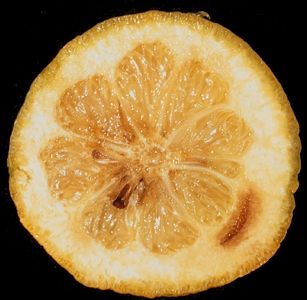
Credit: UF/IFAS
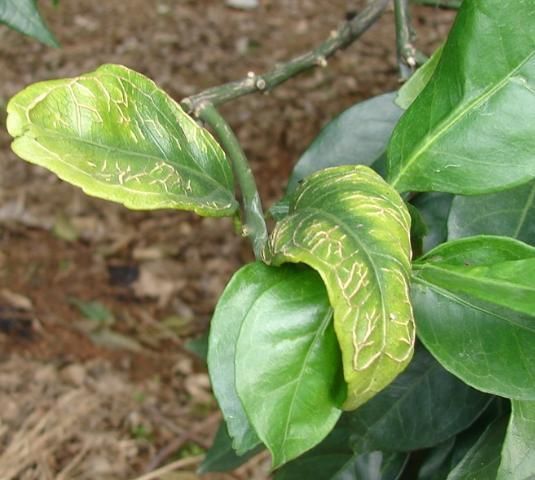
Credit: Mongi Zekri, UF/IFAS
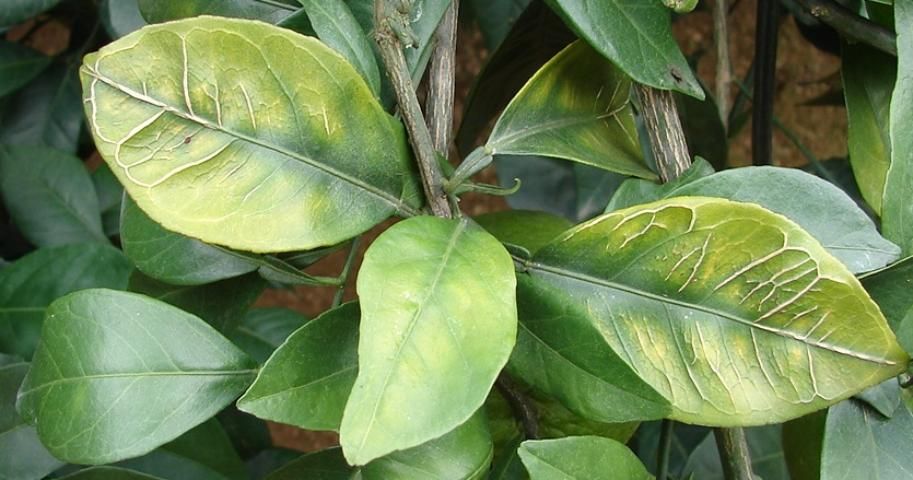
Credit: Mongi Zekri, UF/IFAS
Chlorine Deficiency
Deficiency symptoms of Cl are not commonly observed in most crops growing in the field. Chlorine deficiency has not been seen on citrus. On other plant species, the most commonly described symptom of Cl deficiency is wilting of leaves, especially at the margins. As the deficiency progresses and becomes more severe, the leaves exhibit curling, bronzing, chlorosis, and necrosis.
Leaf analysis standard for assessing Cl and B nutrient status of citrus trees in 4- to 6-month-old spring-cycle leaves from non-fruiting terminals.
Deficiency Correction
Borax (sodium borate) is commonly used to treat B-deficient citrus. This source can be applied either to the foliage or to the soil. Because of its greater solubility, boric acid might be preferred more than borax for foliar spray application. Foliar spray applications are safer and more efficient than soil applications. Foliar sprays may be applied throughout the dormant and post-bloom period but preferably during early flower development. Treating at this growth stage is important because B does not move readily from other parts of the tree to the buds. Applying B at this time will also assist in flower initiation and pollen production, satisfy the needs for pollen tube growth, and enhance fruit set. For maintenance spray applications, 0.25 lb./ac. of B may be used. Where deficiency symptoms are present, double the amount suggested. Use care not to apply more than the recommended amount, because the margin between B sufficiency and toxicity is narrow. During dry weather, applying B to the soil frequently fails to give satisfactory results. If applied during the summer rainy season, then soil application may result in toxicity problems. As a maintenance program, apply B in the fertilizer at an annual rate equivalent to 1/300 of the N rate. If trees are irrigated with reclaimed water, B fertilization may not be necessary.
Boron Toxicity
In Florida, boron toxicity of citrus usually results from the addition of excess borax or similar B materials. The first symptom of B toxicity in the leaves begins with yellowing and death of the leaf tip. These chlorotic areas gradually expand and extend along the leaf margins, creating a mottling effect (Figure 4). Similar symptoms can be caused by urea spray burn and biuret toxicity. Dead areas may develop along the margins near the tips, and leaf drop occurs. The new growth flush following partial defoliation will also show symptoms if toxic levels of B are still present. In severe cases, leaf drop can be extensive, leading to total defoliation, dieback, reduced cropping, and tree death. Because B accumulates progressively as citrus leaves age, the apical mottling is usually more pronounced in late summer and fall. Toxicity due to high B levels in the soil can be reduced by leaching the root zone with low-B irrigation water. Liming of acid soils has also been found to be effective. Boron toxicity can be prevented by exercising care to apply no more than the recommended fertilizer rate.
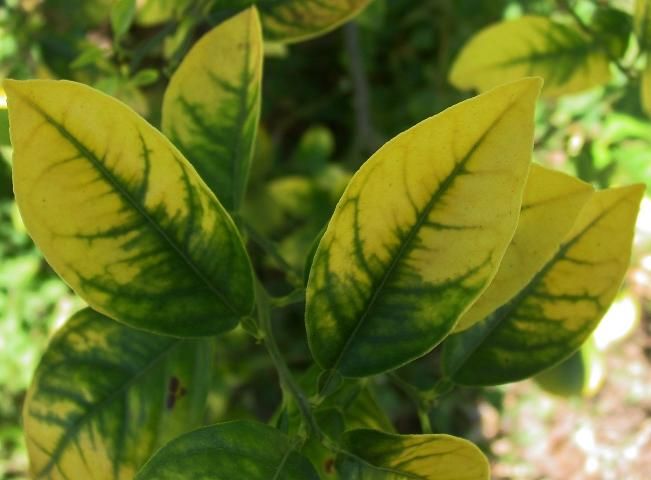
Credit: Mongi Zekri, UF/IFAS
Chlorine Toxicity
The most common source of chlorine toxicity is from chloride in irrigation water. Chloride moves readily with soil water. It can be absorbed by the crop, move in the transpiration stream, and accumulate in the leaves. If the chloride concentration in the leaves exceeds the tolerance of the crop, leaf burn will develop, and leaves can abscise. Normally, plant injury occurs first at the leaf tips and progresses from the tip down along the edges as severity increases (Figure 5). Excessive necrosis (dead tissue) is often accompanied by leaf drop. Many sensitive tree crops begin to show injury with more than 0.3% chloride (dry weight basis). In case of severe defoliation, dieback, and even tree death can result. Older leaves usually show the symptoms first. Similar symptoms can be caused by drought and fertilizer salt burn.
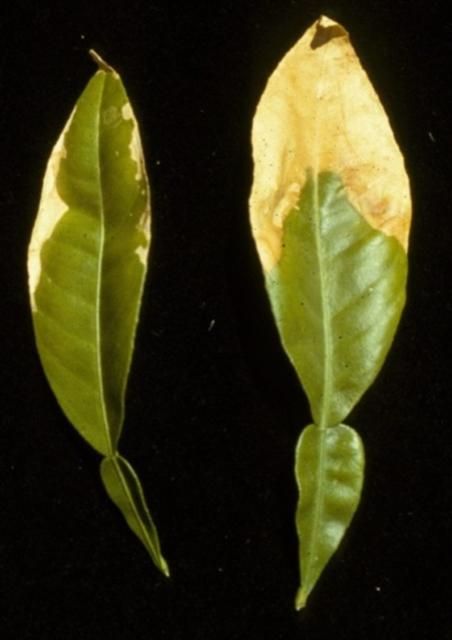
Credit: Mongi Zekri, UF/IFAS
Alleviation of Chlorine/Salt Toxicity
- Frequent irrigation intervals help maintain a low soil-water tension and reduce salt accumulation within the irrigated zone. The volume of irrigation water should be great enough so any accumulated salts are leached below the root zone.
- Split fertilizer applications, and use nutritional materials with low salt index. Avoid the addition of chloride from the application of muriate of potash (potassium chloride).
- Well-managed fertigation with dilute weekly applications at low rates is probably the best solution.
Conclusion
Supplying sufficient nutrition should be a high-priority management practice for every grower. An appropriate nutrient balance using fertilizer management is necessary to achieve sufficient plant nutrition for best fruit yield and quality. If an element is below the critical level, yield production will fall—even though the other elements are kept in good supply. Balanced use of plant nutrients corrects nutrient deficiencies and toxicities; improves soil fertility; increases nutrient- and water-use efficiency; enhances crop yields and fruit quality; develops tree tolerance to pests, diseases, and other stresses; and improves environmental quality.